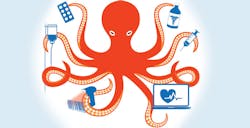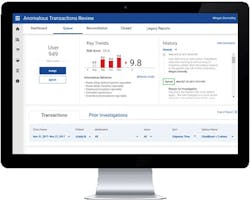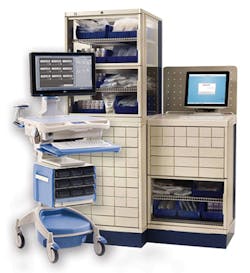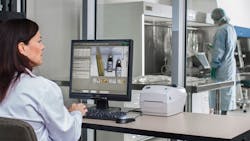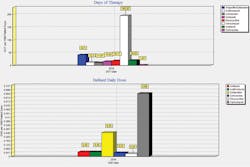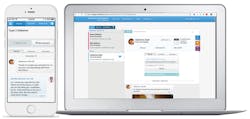The mighty octopus of medication management
Medication management means different things to different departments but always with the common goal of delivering safe, appropriate treatment to every patient. It means adopting systems that will help reduce errors, evaluate potential interactions, identify expired medicines quickly and alert clinicians about recalls in real-time. Medication management also entails implementing tools and processes that are designed to prevent drug diversion, inappropriate prescribing, enhance distribution and tracking, support inventory management and improve stock visibility. Other systems can assist with antimicrobial stewardship, discharge medication orders, medication reconciliations and maintain patient adherence to prescribed treatments. In addition to supporting patient safety efforts, developing the right medication management strategy should also reduce costs, advance clinician workflow and overall efficiencies across departments.
“The medication management process is incredibly complex, and aligning people, technologies, and systems to get a single medication safely to a patient is daunting,” said Tom Utech, VP of Marketing and Strategic Innovation, BD. “Also, it’s estimated [by CMS national health expenditures projections] that prescription drug spending will increase by 6.3 percent per year from 2016 to 2025. An enterprise-wide approach is critical to meeting these challenges — one that includes an interoperable combination of connected technologies and robust analytics.”
Here’s a snapshot of some of the tools now available to help your organization manage its medicines safely and cost-effectively.
Smart storage and dispensing
“To enable full visibility of their facility’s medications, hospitals and health systems must leverage their investments in clinical point-of-care technologies, like medication dispensing and infusion systems,” asserted Utech. “Through BD’s unique ability to integrate its leading technologies, such as BD Pyxis dispensing and BD Alaris infusion solutions — with each other and with the hospital’s EMR — hospitals and health systems have the ability to unlock additional value within their medication management system. BD HealthSight supports hospital systems with horizontal and vertical product interoperability, standardized infrastructure requirements, robust product security, and remote installation and administration. This integration delivers significant value in the areas of medication safety, enterprise-wide inventory optimization, and clinician productivity.”
Advanced analytics provides comparative benchmarking and medication inventory optimization through a single portal. It also provides access to BD tools, resources and services, customized dashboards to help improve pharmacy response to critical medication needs, and enhanced product security and tools to help streamline implementation. “The BD HealthSight platform for enterprise medication management connects systems and processes to help drive a safer, more efficient process including medication storage and preparation — occurring within pharmacy areas — followed by medication distribution to patient care spaces, “said Utech.
Mark Rickert, Global Product Manager, Medication Management Solutions, TouchPoint Medical, describes how the company’s automated dispensing cabinet (ADC) system provides a comprehensive, real-time solution that tracks and notifies credentialed users of which medications are on the floors at any given time to help streamline inventory management and provide clinicians with continuous access to the drugs they need.
“Facilities can improve patient care by getting the right medications to the right patient quickly while tracking and controlling dispensing and stocking of the medications,” said Rickert. “The AccessCenter Automated Dispensing Cabinet accurately and efficiently manages medications and fully supports the facility’s medication management processes with single-drug control, 24/7 access and high-capacity medication storage. The AccessPoint Secure RX Exchange Cassette System supports centralized pharmacy activities, with an exchangeable cassette system and transfer carts to support patient-specific medication workflows. These are ideal medication management solutions that can be accessed and updated in real time with override procedures in place if a needed medication cannot be obtained. There are measures in place to ensure that the right medicine is getting to the right patient in a timely manner. Expiration dates are also monitored so pharmacies can pull old medications from a machine or put it at the top for prompt usage, thereby eliminating waste. An additional benefit includes eliminating time going to the pharmacy or counting medications at the end of shifts and decreasing or avoiding errors,” Rickert continued. “Medication can now be administered in minutes and pharmacists can validate all orders while a report specifies medications to be added to the dispensing cabinet.”
Michael Blondin, Vice President, Solutions Management and Marketing, Swisslog, says hospital pharmacies, which continue to face rising drug costs, shortages and pressure to increase patient engagement and care activities, can manage these challenges with a modern, ADC that offers one-of-a-kind features.
“Forward-thinking pharmacies are taking control of the medication management process by looking to the next generation of pharmacy automation, including BoxPicker Automated Pharmacy Storage System by Swisslog Healthcare,” Blondin said. “Instead of manually picking orders, inviting opportunities for mis-picks and diversion, BoxPicker brings medications right to pharmacy staff. This goods-to-person technology limits access to only one box of medication at a time, requiring every item to be scanned in and out of the system. BoxPicker can pick and dispense patient-specific first doses, as well as ADC and cart fills, while also providing perpetual inventory control. BoxPicker provides dual access points, so one technician can stock medications while a second technician simultaneously picks patient-specific drugs, completes refills for ADCs, or credits and restocks returns. A modular and highly-configurable system, BoxPicker can be right-sized based on the throughput and storage needs of individual pharmacies. Options include multiple workstations with varied locations, anteroom access and temperature control, including ambient, refrigeration and dual-temperature models.”
Blondin says a hospital in Arizona adopted BoxPicker and reduced daily ADC pick time by 6 minutes, time to pick patient-specific first doses 4- to 5-fold, curtail ADC stock outs, allocate additional resources to sterile compounding, and spend more time on medication reconciliation and transition of care activities. Referencing a case study on a non-profit health system in Florida, he says the provider reduced the value of its overall on-hand inventory by over 20 percent, from $3.2 million to $2.5 million just nine months after implementing BoxPicker. “Their pharmacy department also improved inventory turnover by 40 percent, helping to minimize avoidable waste,” he said.
No more dosing errors
According to the ECRI Institute’s 2019 Top 10 Health Technology Hazards, infusion pump medication errors landed at number 6 this year. The concern, more specifically, is when clinicians confuse dose rate with flow rate which can lead to dangerous medication administration errors. “Clinicians tell us that such wrong-field programming errors occur relatively frequently (though such errors often go unreported). Even ‘smart pumps’ that incorporate a dose error reduction system can be misprogrammed in a way that could lead to patient harm,” the authors reported. “Factors that can contribute to wrong-field programming errors include the layout of an infusion pump’s programming screen, the sequence in which infusion programming parameters are listed on the medication administration record (MAR), and the absence of procedures to verify the accuracy of pump programming.” Instead of manually programming infusion pumps ECRI recommends implementing auto-programming, configuring the MAR to match the sequence in which infusion parameters will be entered into the pump, and instituting appropriate double-checks to verify pump programming.
Jan Brase, Director, Medication Delivery, Baxter, discusses step-by-step how more than 440 healthcare facilities and 30,000 active users operate the company’s software solution to make dose accuracy spot-on every time, reduce medication errors and improve efficiency by eradicating the manual process of having to prepare and verify that each dose is correct and safe to distribute.
“The DoseEdge Pharmacy Workflow Manager is a software solution that seamlessly integrates with the pharmacy information system (PIS), which includes barcode scanners, cameras and gravimetric devices that measure final dose weight to automate the process of routing, inspecting, tracking and reporting on intravenous (IV) or oral liquid medication doses,” Brase explained. “DoseEdge can process all five major dose types, including intravenous, chemotherapy, oral liquids, parenteral nutrition and premixed solutions, including frozen premixes. Once an order is placed with the DoseEdge System, it automatically routes doses to the appropriate medication preparation area and allows users to identify orders by type and urgency.
“Next, DoseEdge provides standardized preparation steps—customized to that facility—for pharmacy technicians to follow,” continued Brase. “Barcode scanning of compounding ingredients and/or gravimetric measures of the final dose weight can alert pharmacy technicians to potential errors before they occur. From there, the DoseEdge System captures high resolution digital images of each dose, including the actual volumes used for preparation as well as key details like dose calculations, preparer, products used, lot numbers and expiration dates. These details enable pharmacists to remotely approve, reject or request rework without entering the cleanroom. Barcode tracking lets pharmacies continually track all prepared doses as they move through a facility, from preparation to delivery. Finally, DoseEdge provides detailed reporting on every dose, including errors prevented, productivity, bypassed doses and recycled doses. Pharmacies can also create custom reports to help stay compliant with regulatory requirements. To date, the DoseEdge Pharmacy Workflow Manager has intercepted more than 7 million potential medication errors.”
Advancing antibiotic stewardship
Cody Canon, Customer Success Manager, CKM Healthcare, describes how the company’s infection prevention and control software system offers an antibiotic stewardship module that improves processes and promotes right-drug-for-the-bug prescribing, which helps reduce resistance to antibiotics, and the numerous health dangers and costs associated with wrongful prescribing.
“The module utilizes pharmacy orders for antibiotics and leverages many tools that help manage antibiotic use,” said Canon. “A popular feature of the module is an Antibiotic Timeout function. This function uses an intuitive stoplight feature, enabling identification of orders for review by a pharmacist 48 hours after the order time. The pharmacist can easily see orders that have reached the timeout and review patient vitals and recent orders for effectiveness, appropriateness, and review of drug interactions while tracking interventions in one place. This practice increases the potential for pharmacist informed IV to PO drug conversions, catching drug-bug mismatches, and encourages changing expensive broad-spectrum antibiotic use for a less expensive narrower scope antibiotic. By using the best antibiotic, hospitals aid in reducing the proliferation of multi-drug resistant organisms.
“CKM also provides Days of Therapy (DOT) and Defined Daily Dose (DDD) graphs and reports at the click of a button,” continued Canon. “These extremely complicated, labor intensive calculations are used to analyze antibiotic usage within a facility and to benchmark performance both internally and with the World Health Organization and can be done in seconds, saving pharmacy and/or decision support teams upwards of several weeks or months to manually generate. The module also provides an antibiogram that uses historical microbiology lab results to determine each of the unique organism’s resistance profiles in the facility. This helps healthcare workers in choosing the most appropriate antibiotic for prescription before a full culture analysis has been completed. Manually creating an antibiogram can take weeks or months of a microbiologist’s time. In contrast, creating an antibiogram using the CKM Pharmacy module takes seconds or minutes. Filters are utilized to remove duplicates and customize which cultures are used for calculations.”
Discharge support
Brian Roberts, CEO of PipelineRx, explains how his organization’s analytics-supported patient discharge solution brings pharmacists and clinicians together to ensure patients who need to remain on a course of medication at home receive the information and support they need to comply with their treatment plan and avoid potential readmissions from complications related to nonadherence.
“The discharge process can be a confusing and chaotic time for patients, and hospital staff; oftentimes, patients are discharged from the hospital without clear instructions on when and how they should be taking their medications, which ends up accounting for nearly 26 percent of readmissions,” said Roberts. “The PipelineRx Patient Discharge Solution helps pharmacists take a leading role in educating patients on their medications as they leave the hospital. Analytics are used to identify high-risk patients immediately at admission so that pharmacists can monitor the patient throughout the entirety of their stay, continuously documenting information in the PipelineRx Patient Discharge platform, including inpatient medication orders and outpatient prescription history.
“Prior to discharge, pharmacists use the software to do a real-time prescription benefits check before reviewing costs with the patient, to determine if the patient has any financial barriers,” continued Roberts. “To make the transition from hospital to home seamless, pharmacists then generate a patient-friendly “Med Card” and review it with the patients and their caregivers to ensure a complete understanding of the medications for increased adherence. The PipelineRx software tracks post discharge follow-up by pharmacists and nurses and allows for the hospital staff to receive alerts when patients don’t pick up their prescription, initiating follow-up contact to discuss any potential issues and help the patient stay on their medication regimen to avoid medication-related readmissions.
Studies have shown that when pharmacists are involved in the discharge process, readmissions can be reduced by half. Studies have also shown that one-third of prescriptions will not be picked up post-discharge. The solution can improve patient satisfaction and outcomes, while decreasing readmissions and associated penalties to boost the hospital’s or health system’s bottom line. This comprehensive solution also directly improves pharmacy-nursing coordination and satisfaction by making the discharge process more streamlined and collaborative — for the benefit of the patient.”
Monitoring the outpatient
Todd Johnson, Senior Vice President, General Manager of Ambulatory Care, GetWellNetwork, discusses the company’s GetWell Loop solution, which engages patients leaving the ambulatory center to take a greater role in their treatment plan. The system’s analytics provides information tailored to each patient’s specific episode of care and medical history.
“Proper management of prescribed medications is a top patient-safety concern, and compliance is at the heart of most acute and chronic care patient journeys,” said Johnson. “Medication non-adherence happens for a variety of reasons, including a misunderstanding of the instructions, forgetfulness, confusion surrounding multiple medication regimens, financial burden, etc. In fact, according to the FDA, 20 percent to 30 percent of prescription drugs never get filled by a pharmacy and half of the time, prescribed medications are not taken as directed. Using real-time feedback and analytics, the system identifies patients that need help, allowing clinical teams to intervene before costs and complications escalate. Patients that are put on GetWell Loop care pathways receive information around managing their medication, general educational patient resources, daily reminders and tasks to guide them through self-care and monitoring related to their condition.
“GetWell Loop’s automated check-ins look at a patient’s engagement over time to monitor compliance; for example, GetWell Loop prompts patients to meet with their prescribing providers or specialists for guidance on when to stop, re-start or change the doses of any medications,” continued Johnson. “During check-ins, patients review the content in their care pathway and provide responses in the form of structured data. This data provides unique insight into patients that’s proven to improve outcomes and patient satisfaction. Anthem, Inc. & GetWell Loop completed a multi-center control trial to study the effect of GetWell Loop on 90-day post-acute costs following total joint replacement. The partnership generated a 54 percent reduction in complications and a 45 percent reduction in patient re-admissions, averaging a $656 savings per episode. GetWell Loop offers more care pathways off the shelf—over 160—that cover providers most common patient populations.”
About the Author

Valerie J. Dimond
Managing Editor
Valerie J. Dimond was previously Managing Editor of Healthcare Purchasing News.
